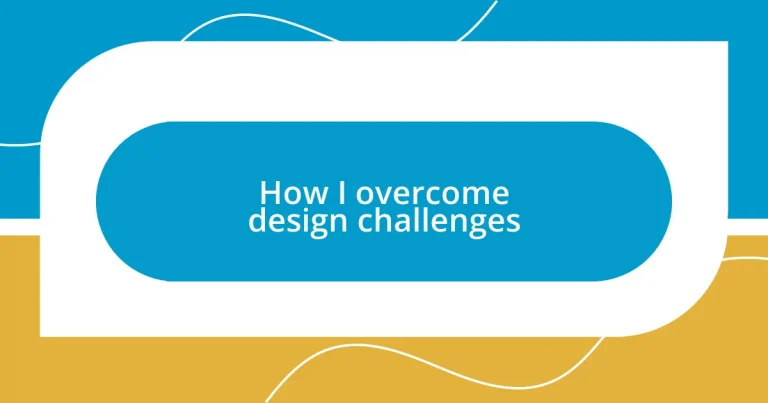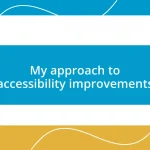Key takeaways:
- Aligning client expectations through deep discussions and prioritizing core design elements is crucial for balancing creativity and brand identity.
- Empathizing with users and gathering feedback through workshops and prototype testing leads to designs that truly resonate with their needs and experiences.
- Implementing final designs confidently involves trusting the iterative process, engaging users during rollouts, and celebrating small successes to reinforce belief in the work.
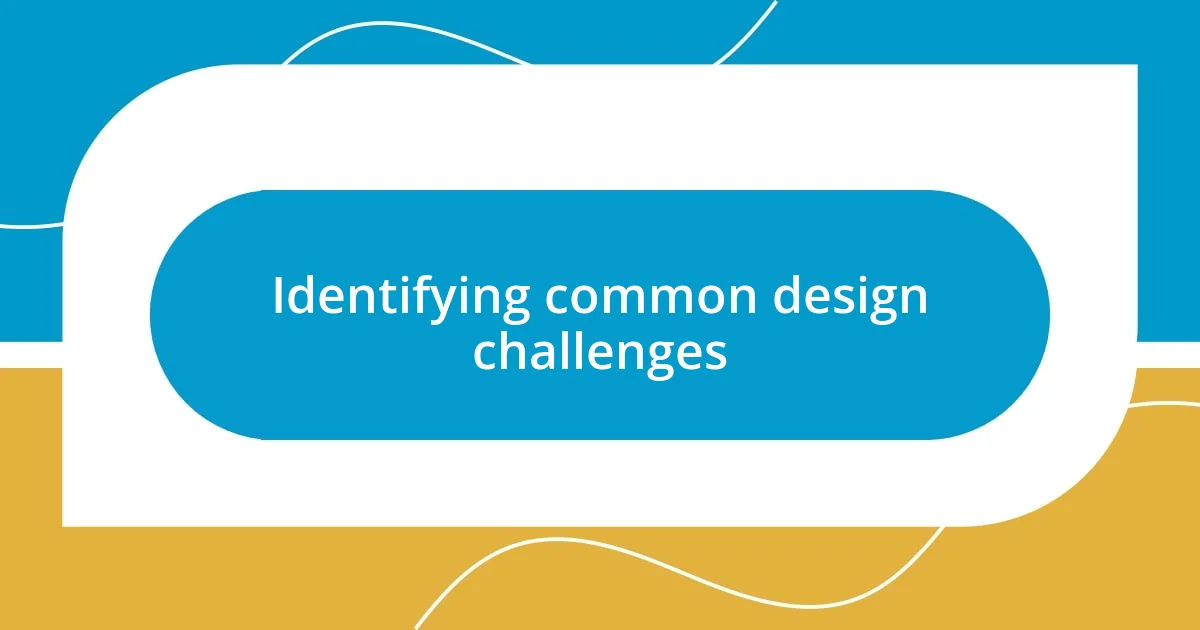
Identifying common design challenges
When I reflect on my design journey, one common challenge that often resurfaces is the struggle with client expectations. I remember a project where the client wanted a bold, innovative look while also sticking to a traditional brand identity. How do you balance creativity with the familiar? It requires not only skill but also deep conversations to align visions, ensuring that the final product resonates with both the brand’s heritage and contemporary trends.
Another challenge I’ve faced is working within tight deadlines. I once had a project where the timeline for creating a comprehensive brand design was cut in half due to unforeseen circumstances. It felt like a pressure cooker situation. How do you maintain quality when racing against the clock? For me, it meant prioritizing tasks and focusing on the core components of the design that would make the most significant impact, allowing for rapid iterations and feedback cycles.
Lastly, staying updated with design trends can be overwhelming. I often find myself in a cycle of learning and unlearning as new styles emerge. Have you ever felt the pressure to push boundaries while also keeping your work relevant? In my experience, the key has been to embrace a mindset of continual growth, allowing me to absorb influences from both current trends and timeless principles, striking a balance that feels authentic to my design ethos.
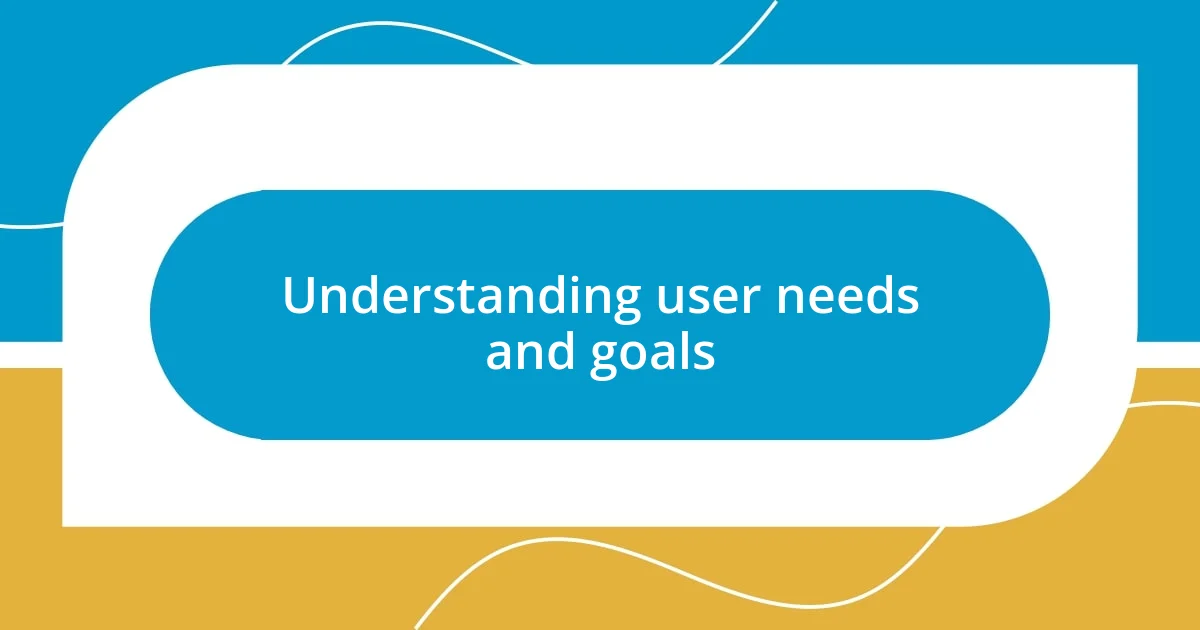
Understanding user needs and goals
Understanding user needs and goals is fundamental in any design process. I recall a project where we struggled to grasp the specific requirements of a user group. After a few rounds of assumptions and misunderstandings, we decided to hold a series of workshops directly involving users. It was astonishing to hear their perspectives firsthand, illuminating needs we would never have identified otherwise. Their insights transformed the design direction and enhanced our final product significantly.
Listening to users is not just about gathering feedback; it’s about empathizing with their experiences. During another project, we created a user persona based on research, but the real breakthrough came when I began sharing our prototypes with actual users. Their reactions unveiled unanticipated pain points. Seeing users interact with our design sparked a renewed passion in me to dig even deeper into their motivations and frustrations. It’s these personal connections that inform my designs and make them genuinely user-centric.
I’ve also learned the value of setting clear goals derived from user needs right at the start. On a collaborative project, we outlined specific user goals, which acted as our guiding compass. When doubts surfaced mid-project, we would revisit those goals, which helped keep us aligned and focused. It’s amazing how much clarity this brings, ensuring that every design decision contributes toward fulfilling user requirements. Ultimately, understanding user needs shapes every layer of the design process, reflecting their aspirations and real-world challenges.
| Method | Description |
|---|---|
| User Workshops | Facilitating discussions to gather user insights directly. |
| User Feedback | Testing prototypes with real users to uncover pain points. |
| Goal Alignment | Establishing clear user-centric objectives at the start. |
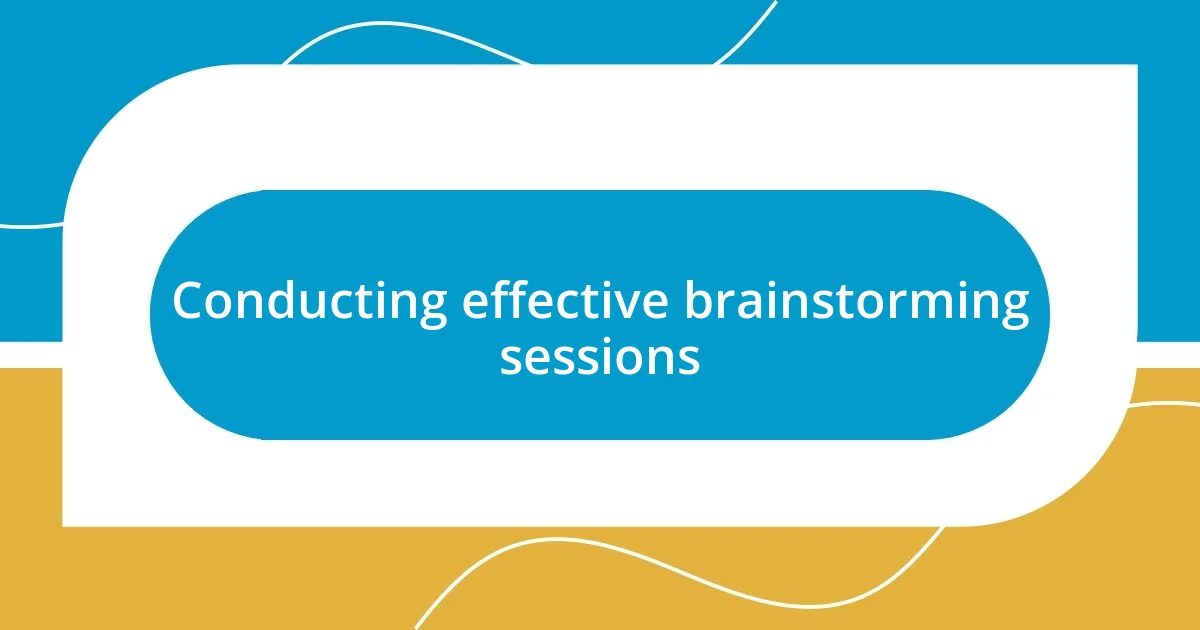
Conducting effective brainstorming sessions
Conducting effective brainstorming sessions can truly elevate the creative process. I vividly recall a time when my team faced a stagnation in ideas for a project. To shake things up, we decided to switch up our environment and host our session in a local café instead of the usual conference room. The change in scenery did wonders! It sparked lively conversations and helped us flow freely without the constraints of a formal setting. When the atmosphere is relaxed and inviting, creativity seems to thrive.
- Choose a unique location to inspire fresh ideas.
- Encourage all team members to share input—evaluating contributions fosters a sense of ownership.
- Set a clear goal for the session to keep everyone focused and engaged.
One important lesson I’ve learned is to set time limits for each brainstorming idea. I remember feeling frustrated as discussions meandered aimlessly during earlier sessions. By incorporating a timer, the energy shifted, and suddenly, we had a sense of urgency that propelled us to think faster and bolder. The ideas flowed more freely, and we left with a treasure trove of concepts to explore. Keeping it brisk can unveil unexpected insights.
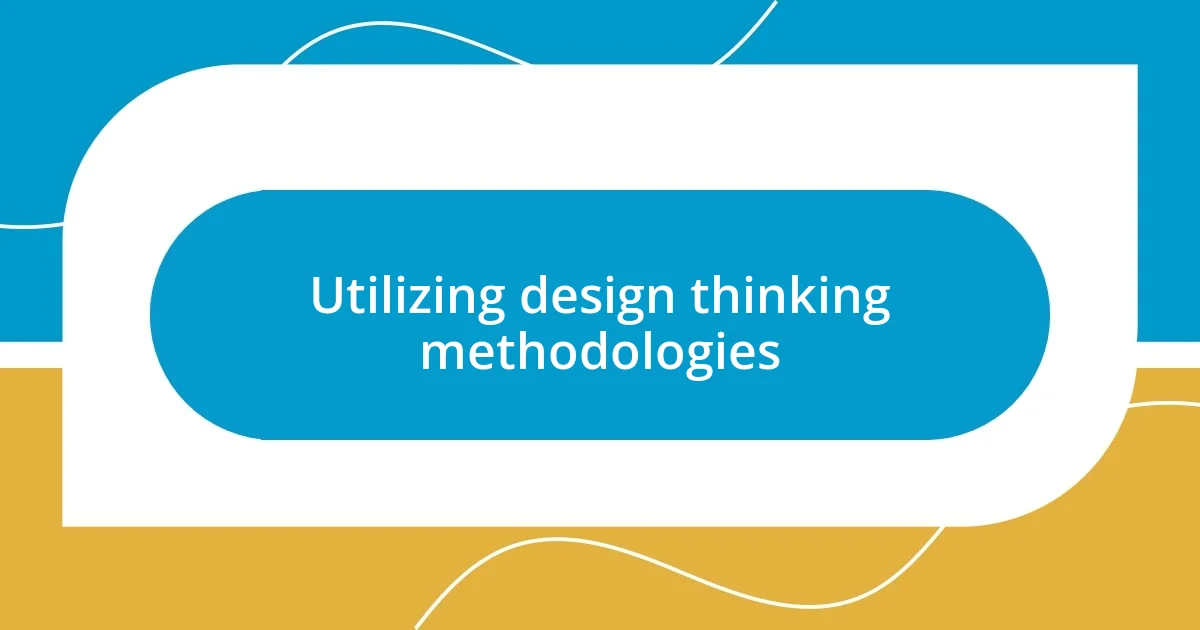
Utilizing design thinking methodologies
Utilizing design thinking methodologies has been a game-changer in how I approach problem-solving in design. For instance, in a recent project, we adopted a rapid prototyping approach. Instead of overthinking every detail, we created quick, iterative versions of our design. Each prototype became a stepping stone, allowing us to refine our ideas based on user feedback. I remember the thrill of seeing a user’s eyes light up when they engaged with a version of our design—it was a powerful reminder that creating iterations opens the door to discovery.
I’ve also found that empathy mapping is an invaluable tool in the design thinking process. While working on a mobile app, we used this method to visualize user feelings, thoughts, and actions. It stirred meaningful conversations within the team, prompting us to consider how our design could alleviate user frustrations. Each map session felt like a deep dive into the hearts and minds of our users. Have you ever thought about how your designs resonate with the emotions of those who will use them? Engaging in empathy mapping helped me see our users’ journeys in vivid detail, reminding me that every choice we make can either enhance or hinder their experience.
Additionally, I align my team around a shared vision by employing the “How Might We” question framework. In one project, we faced complex challenges that seemed insurmountable at first. By rephrasing our challenges into “How might we…” questions, we transformed obstacles into opportunities for innovation. This simple shift harnessed collective creativity, as team members felt empowered to brainstorm solutions. Now, whenever I feel stuck, I ask myself: “How might I turn this challenge into a breakthrough?” That mindset not only fuels creativity but infuses purpose into our design process, driving us closer to fulfilling user needs.
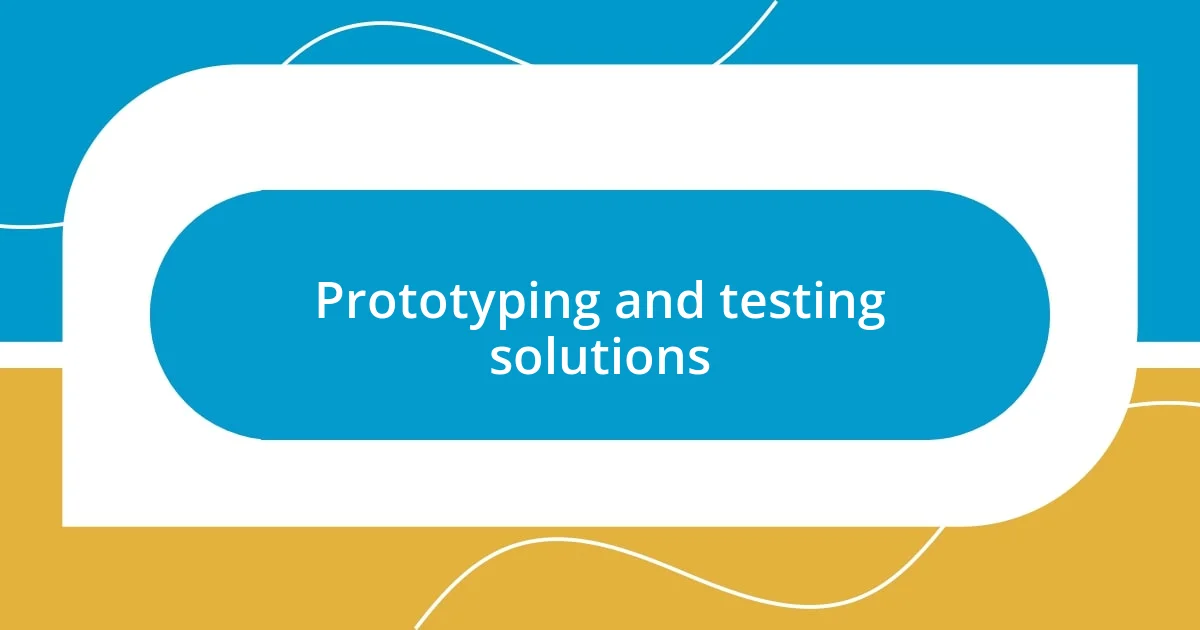
Prototyping and testing solutions
Creating prototypes and testing solutions is where the magic truly happens in design. I once worked on a web app where the initial concept felt right, but something was missing. I decided to create low-fidelity screens to visualize user paths. When I tested these prototypes with real users, their reactions were eye-opening. They navigated in unexpected ways, highlighting features I thought were clear but weren’t. It was a humbling experience, reinforcing the idea that assumptions often lead us astray.
During testing, I learned to embrace failure as a tool for growth. I remember a particular prototype that flopped during user testing; it was so far from what users needed that I felt disheartened. However, pushing past that moment of disappointment allowed us to pivot quickly. In our next iteration, we focused on the pain points our users voiced and created a solution that not only satisfied but excited them. Have you ever felt that rush when you finally land on a solution after what seemed like countless trials?
Each cycle of prototyping and testing builds a narrative of progress, and it’s those small victories that fuel my passion for design. Implementing user feedback isn’t always easy—sometimes it feels daunting to revisit your ideas—but I’ve learned that each iteration brings clarity and confidence. The process may feel circuitous, but I now view it as an exhilarating journey; the more I refine, the closer I get to achieving a design that truly resonates with users. Wouldn’t you agree that every setback can be reframed as a stepping stone towards innovation?
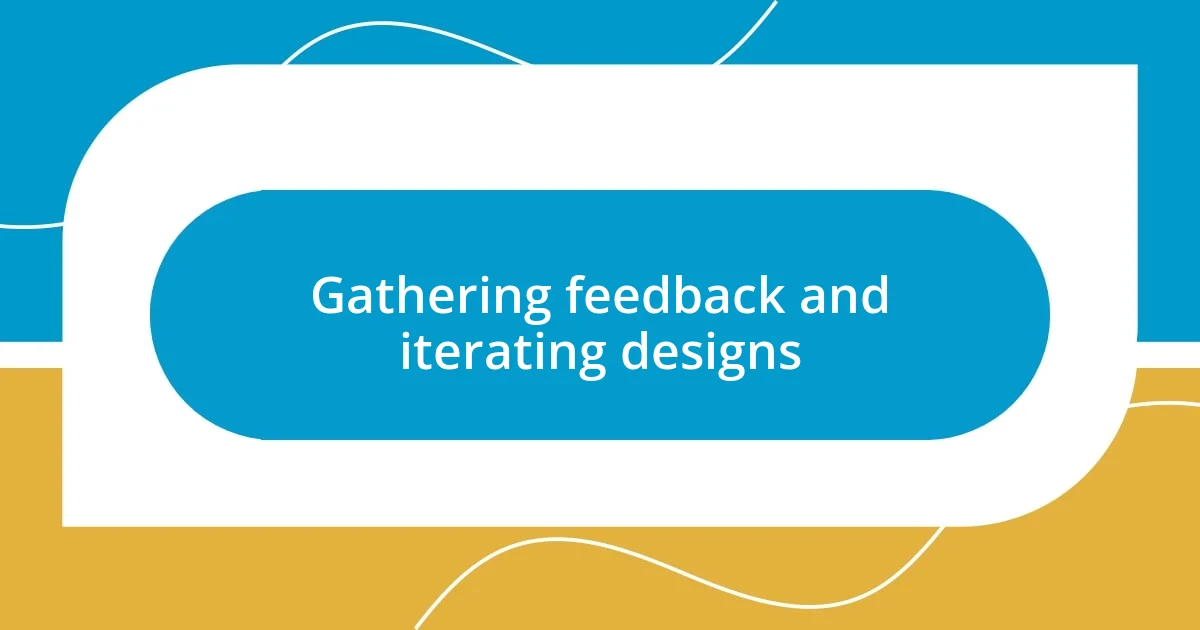
Gathering feedback and iterating designs
Gathering feedback is an essential part of the design process. I remember a project where I organized a feedback session, inviting users to share their thoughts candidly. The insights they provided were often surprising, revealing preferences and pain points that I hadn’t considered. It made me realize how crucial it is to listen actively—those moments of honest feedback can be a treasure trove for refining designs.
Iterating designs based on user feedback can feel intimidating, especially when it comes to changing features you’ve invested time and energy into. I experienced this firsthand when a user pointed out that a particular button was not intuitive. Initially, I was resistant to change, but after reflecting, I understood the importance of prioritizing user experience. Embracing that feedback sparked a series of adjustments, ultimately leading to an improvement that elevated the entire project. Isn’t it fascinating how a single suggestion can reshuffle our priorities and enhance our work?
In my experience, each iteration not only improves the design but also deepens my connection with users. When I see users engaging with our changes, it sparks joy and reinforces the idea that design is a collaborative journey. Have you ever noticed how much more satisfying it is to see your work evolve with direct input from those who interact with it? It’s the cycle of feedback and iteration that transforms initial ideas into effective solutions, fulfilling the very needs they are meant to address.
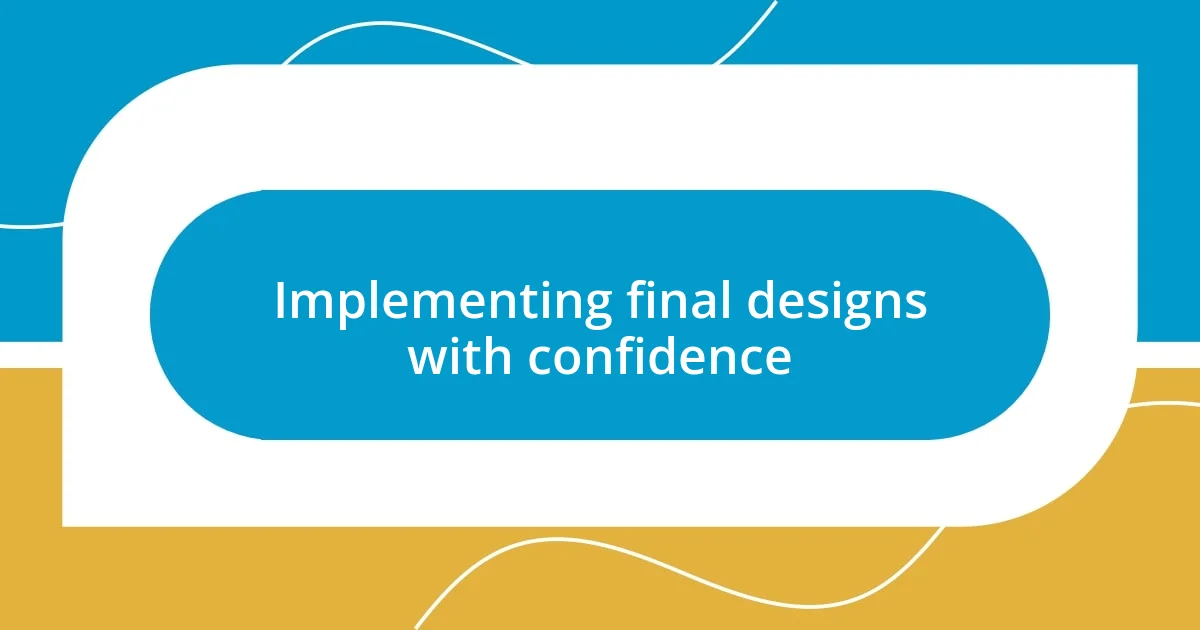
Implementing final designs with confidence
Implementing final designs is a step that can feel both exhilarating and nerve-wracking. I remember when I was about to launch a mobile application I had poured my heart into. As the final countdown ticked down, I felt a rush of anxiety mixed with excitement. It’s almost like standing at the edge of a diving board, unsure whether the water below is clear. But what I’ve learned is that having confidence in my designs comes from trusting the process I’ve followed. Each critique, every iteration, and all those late nights of tweaking—when the moment arrives to share your work, it carries the weight of that entire journey.
What really helped me implement final designs with confidence was creating a structured rollout plan. I recall introducing a feature in incremental phases, which allowed me to gather real-time feedback without overwhelming users. At first, the response was mixed, and I felt that familiar twinge of doubt. However, recognizing that initial feedback was just part of the process transformed my mindset. It was a reminder that even the most polished designs could benefit from user interaction. Engaging our audience during the rollout made me realize I wasn’t just a designer; I was a partner in their experience.
I often tell myself that confidence isn’t the absence of fear—it’s the ability to move forward despite it. As I reflect on these moments, I find that celebrating small wins helps too. Perhaps it was the way users embraced a new feature or the appreciative messages I received. These validations reinforced my belief in my work, turning nerves into motivation. Have you ever found strength in the support of your user community? It’s that connection that solidifies our designs, making the entire process worthwhile.












